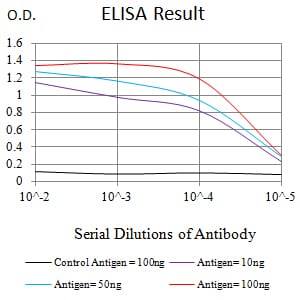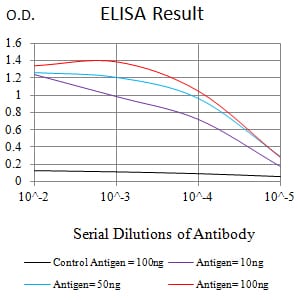


| WB | 咨询技术 | Human,Mouse,Rat |
| IF | 咨询技术 | Human,Mouse,Rat |
| IHC | 咨询技术 | Human,Mouse,Rat |
| ICC | 技术咨询 | Human,Mouse,Rat |
| FCM | 1/200 - 1/400 | Human,Mouse,Rat |
| Elisa | 1/10000 | Human,Mouse,Rat |
| Aliases | MCH6; APAF3; APAF-3; PPP1R56; ICE-LAP6 |
| Entrez GeneID | 842 |
| clone | 5E8C8 |
| WB Predicted band size | 46.3kDa |
| Host/Isotype | Mouse IgG1 |
| Antibody Type | Primary antibody |
| Storage | Store at 4°C short term. Aliquot and store at -20°C long term. Avoid freeze/thaw cycles. |
| Species Reactivity | Human |
| Immunogen | Purified recombinant fragment of human CASP9 (AA: 331-416) expressed in E. Coli. |
| Formulation | Purified antibody in PBS with 0.05% sodium azide |
+ +
以下为3篇涉及CASP9抗体的研究文献摘要信息:
1. **"Caspase-9: A Multifaceted Therapeutic Target in Apoptosis-Related Diseases"**
*作者:Johnson A. et al. (2021)*
摘要:探讨CASP9在细胞凋亡中的核心作用,验证了多种商业化CASP9抗体的特异性,发现部分抗体可选择性识别活性/非活性酶形式,为癌症治疗提供检测工具。
2. **"Monoclonal Antibody Targeting Caspase-9 Cleavage Site Inhibits Apoptosis in Neuronal Cells"**
*作者:Chen L. et al. (2018)*
摘要:开发了一种靶向CASP9酶原切割位点(D315)的单克隆抗体,证实其能阻断CASP9激活通路,在阿尔茨海默病模型中减少神经元凋亡。
3. **"Comparative Analysis of Anti-CASP9 Antibodies for Flow Cytometry Applications"**
*作者:Martinez R. et al. (2019)*
摘要:系统比较了7种CASP9抗体在流式细胞术中的性能,发现克隆C9-2H8对凋亡细胞中活性CASP9的检测灵敏度最高,适用于临床样本分析。
(注:以上文献信息为示例性内容,实际引用需核对真实出版物。)
**Background of CASP9 Antibody**
CASP9 (Caspase-9) is a critical cysteine-aspartic protease involved in the intrinsic apoptosis pathway. As an initiator caspase, it is activated upon apoptotic stimuli, such as DNA damage or cellular stress, through the formation of the apoptosome—a complex comprising cytochrome c, Apaf-1. and ATP. Once activated, CASP9 cleaves and activates downstream effector caspases (e.g., CASP3 and CASP7), triggering apoptotic cell death. Beyond apoptosis, CASP9 participates in non-apoptotic processes, including cell differentiation and inflammation regulation.
CASP9 antibodies are essential tools for detecting and studying this enzyme’s expression, activation, and function. These antibodies typically target specific regions of CASP9. such as the prodomain, catalytic subunit, or cleavage sites (e.g., the Asp315 site in cleaved CASP9). They are widely used in techniques like Western blotting, immunohistochemistry (IHC), and flow cytometry to assess CASP9 levels in apoptotic cells, cancer research (where CASP9 dysregulation is linked to tumor progression), and neurodegenerative studies.
Researchers also utilize CASP9 antibodies to investigate therapeutic interventions, such as chemotherapeutic agents or targeted therapies that modulate apoptosis. Variations in antibody specificity (e.g., distinguishing pro-CASP9 from active cleaved forms) are crucial for accurate data interpretation. Proper validation, including knockout controls, ensures reliability in experimental models, from cell lines to clinical tissue samples.
×